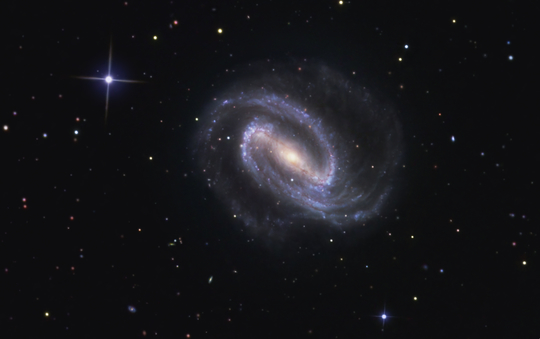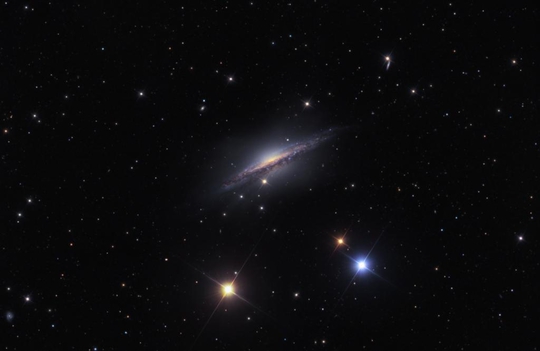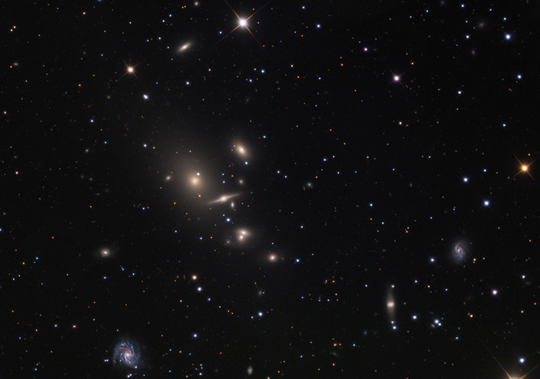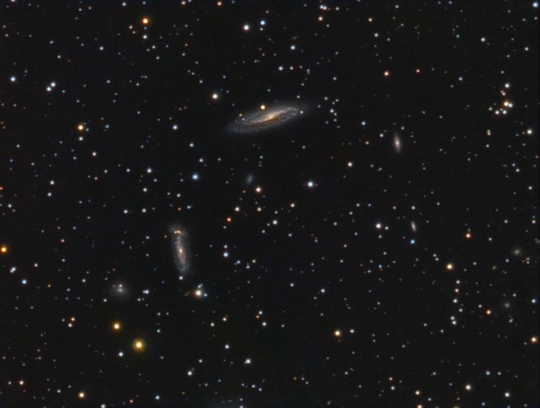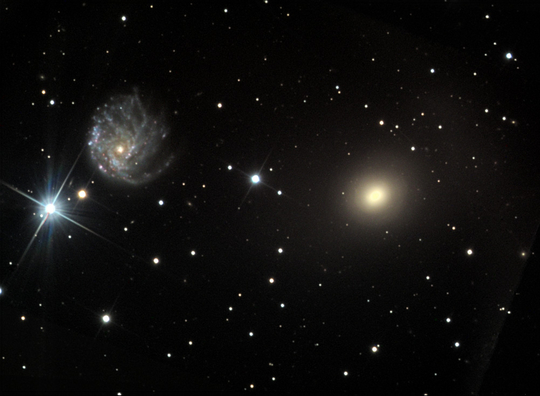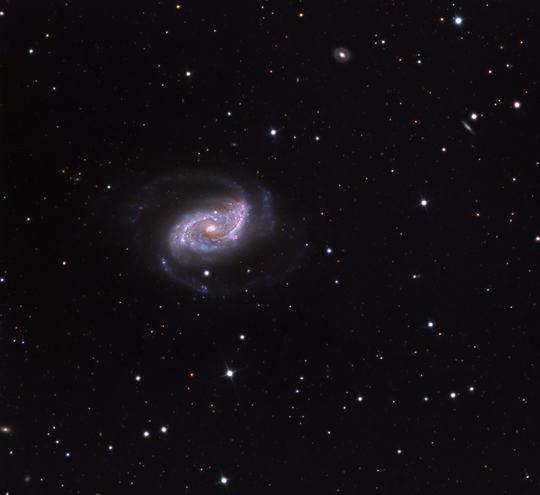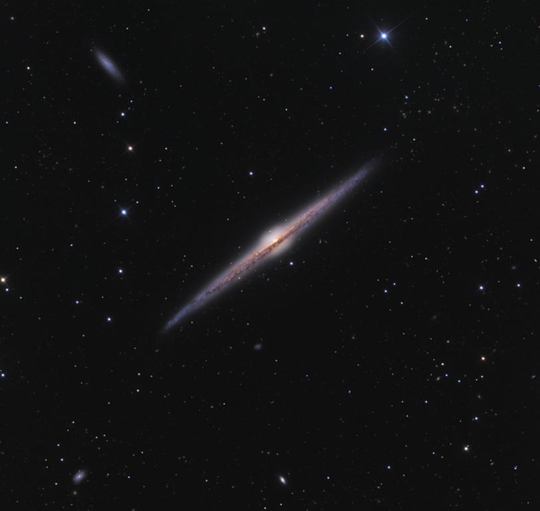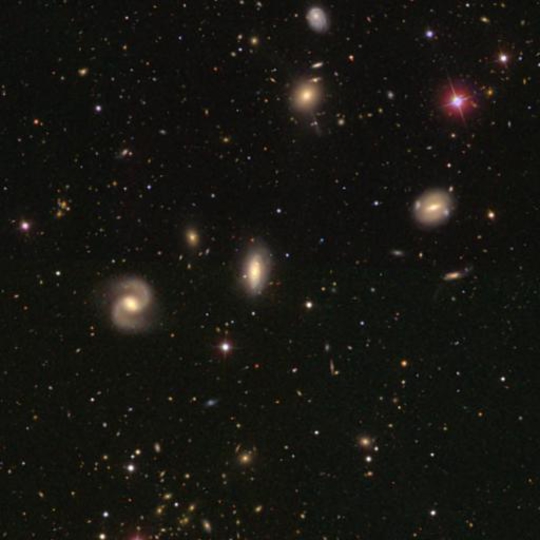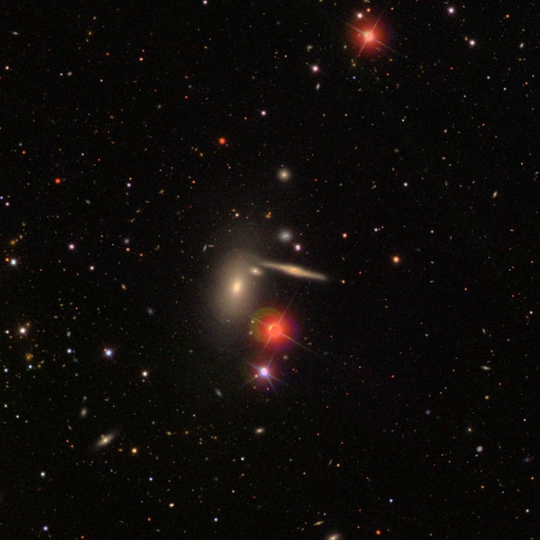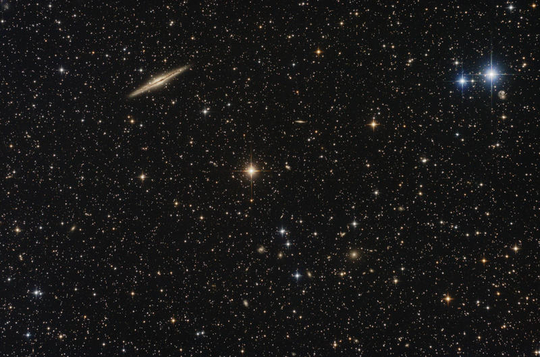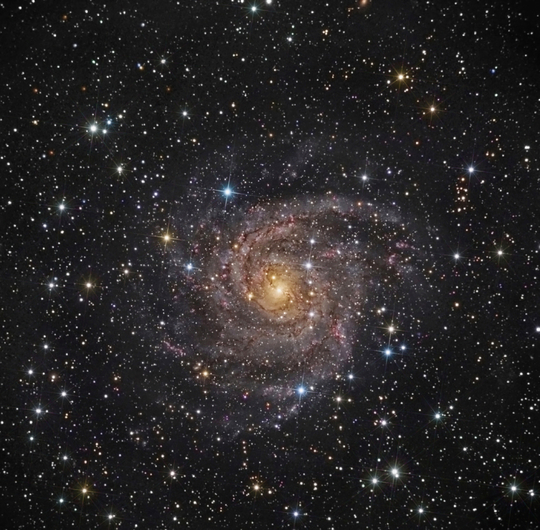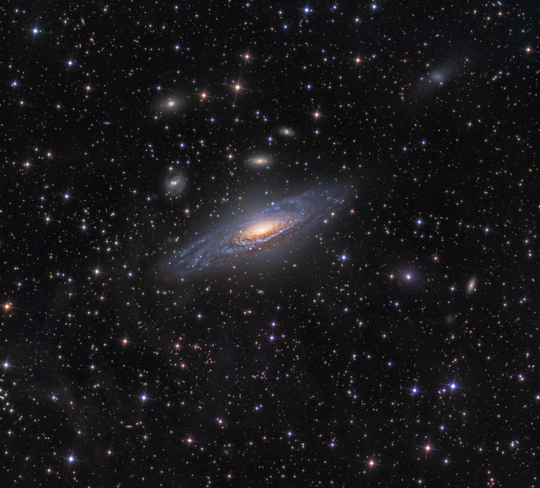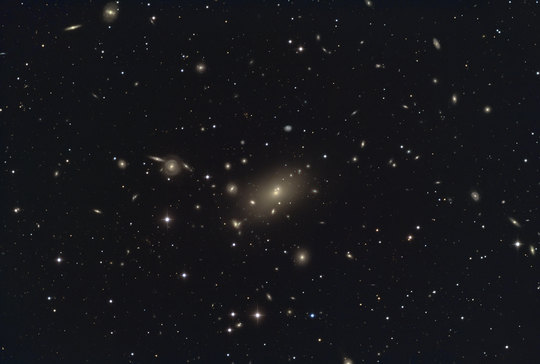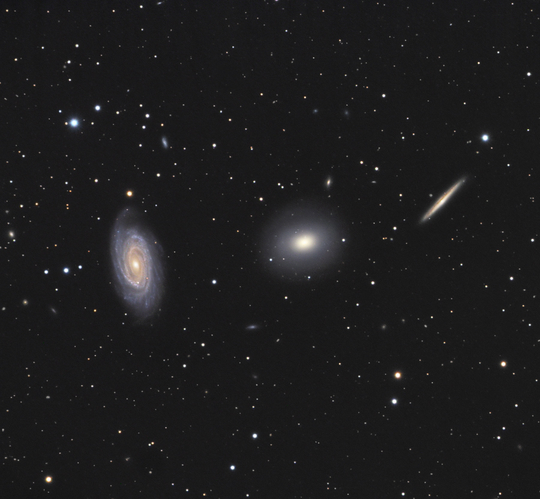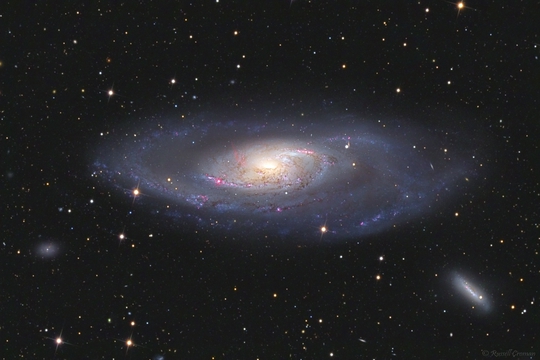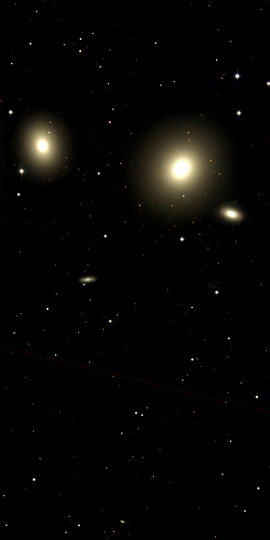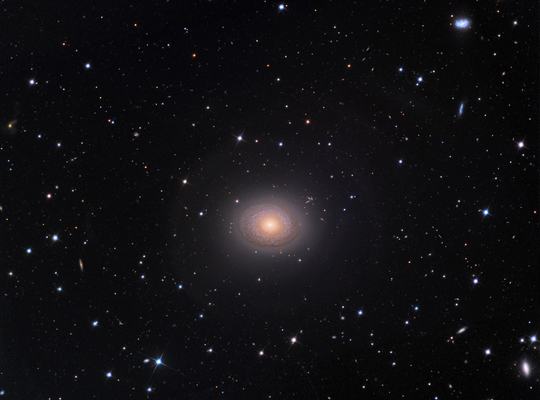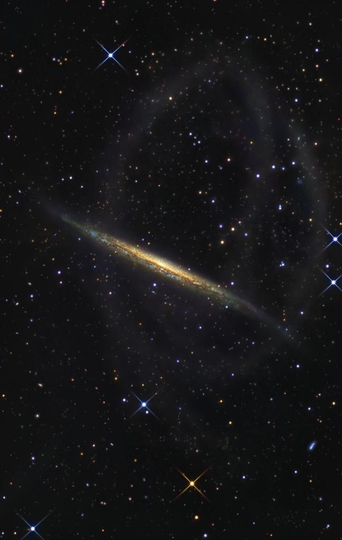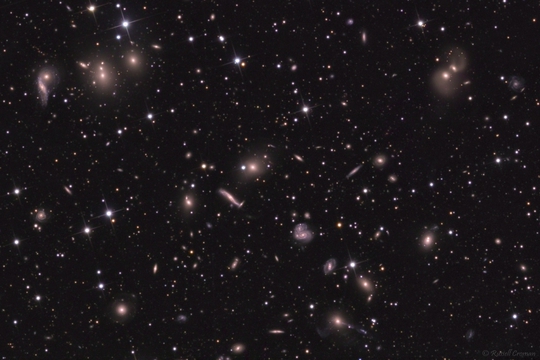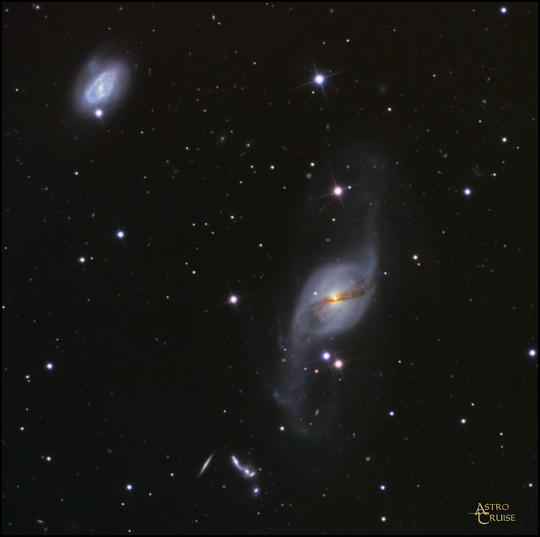Galaxy of the Month Archive before 2014
-
December 2013 - Galaxy of the Month
NGC 1300 in Eridanus
Image Courtesy of R Jay GaBany, USA. For more images from R Jay GaBany please visit the Cosmotography website. You can click on image for a high resolution version.
Most of the galaxies we have covered so far in the galaxy of the month column have been primarily aimed at northern observers. This month’s object is perhaps aimed more at mid northern observers. NGC 1300 lies in the constellation of Eridanus and was discovered by John Herschel in 1835 using the 18.7" reflector from his observatory at Feldhausen on the Cape.
It is a classic barred spiral that has, amongst other things, the distinction of being one of the largest images of a single galaxy made by the Hubble Space Telescope. It is often touted as the finest example of a barred spiral, although many would suggest the great Fornax spiral NGC 1365 is a better example.
The galaxy is unusual for a spiral in that it does not appear to contain a black hole at the centre. The main features of the galaxy as can be seen is that it is a barred spiral, however detailed observations of centre disk of the galaxy suggest it shows its own grand design spiral pattern which does not necessarily tie up with the larger pattern. This structure is actually not that unusual in some of the larger barred spirals.
The NGC 1300 lies about 69 million light years away and appears to be part of the Eridanus galaxy group (Or Fornax II cluster) which is in turn a sub group of the Eridanus Cloud. This is a loose cluster of galaxies that appears to include about 200 galaxies that are condensing out of the general Hubble flow. The Eridanus Cloud also includes as a separate subgroup the better known Fornax cluster. The majority of galaxies (70%) in the Eridanus cloud appear to be either spiral or irregular. The size of NGC 1300 at a suspected 110,000 light years puts it at about the size of our Milky Way galaxy.
Observationally from northern latitudes NGC 1300 is going to be a challenge as it is always going to lie low on the southern horizon. Using a 15" telescope shows a nice bar with a bright core surrounded by a haze even though the altitude of observation was only about 19 degrees. Observations with larger telescopes and from more southerly location suggest that it will show nice spiral arms along with some detail in the spiral arms. In the same medium power field of view there is also the tight spiral galaxy NGC 1297 which is also part of the same group.
Owen Brazell - Galaxy Section Director
-
November 2013 - Galaxy of the Month
NGC 1055 in Cetus
Image Courtesy of Ken Crawford, California. For more images from Ken Crawford please visit the Rancho Del Sol Observatory website. You can click on image for a high resolution version, or download a copy of our Megastar© Finder Chart of the NGC 1055 and M77 region.
NGC 1055 was first discovered by William Herschel in 1783 from Slough. It is an edge on spiral galaxy not dissimilar to M104 (the Sombrero) in Virgo. The dark dust lane and bright star forming regions are believed come from its interaction with the nearby spiral galaxy M77. Indeed a low power eyepiece view will show both galaxies in the same field as they are only separated by about half a degree (a full moons width).
There is a nice image showing galaxies at NASA's APOD. The interaction with M77 also means that NGC 1055 is a bright infra-red and radio source. Images in the ultraviolet by the GALEX satellite show the blue star forming regions very clearly even though they may be overshadowed by the dust lanes. The disk as indicated by the dust lanes appears warped which is also probably a result of the interaction. NGC 1055’s nuclear region also shows some of the properties expected form a LINER galaxy although it is not clear if it is one. It does appear quite boxy and large.
Current distance measurements place NGC 1055 at 45—60 million light years and if this is so then the spatial distance between M77 and NGC 1055 is probably only about 500,000 light years, less than a quarter of the distance between ourselves and M31. This distance would also give NGC 1055 a diameter of about 100,000 light years, comparable in size to our own Milky Way.
Detailed images of NGC 1055 show structures in its halo that may well be star streams from disrupted companion galaxies.
NGC 1055 is one of the dominant members along with M77 of a small group of galaxies known as the M77 group which also includes the galaxies NGCs 1055 (type Sb) and 1073 (type SABc), as well as UGCs 2161 (DDO 27, type Im), 2275 (DDO 28, type Sm - designating a morphological type between spirals and irregulars) and 2302 (DDO 29, type Sm), and the irregular galaxy UGCA 44 and the SBc barred spiral Markarian 600.
NGCs 1087 (Sc), 1090 (S-), and 1094 (SABb-) although nearby on the sky are actually background galaxies, as their much higher redshift indicates.
The M77 group is about the same distance from us as the Virgo cluster but in a different direction. Visually NGC 1055 maybe more challenging to get details out of than images may suggest and although it may be seen in relatively small telescopes to see any detail is likely to require a telescope of 30cm or above aperture in typical UK skies.
Owen Brazell - Galaxy Section Director
-
October 2013 - Galaxy of the Month
Abell 262 Galaxy Cluster in Andromeda
Image Courtesy of Adam Block/Mount Lemmon SkyCenter/University of Arizona. For more images from Adam Block please visit the Mount Lemmon SkyCenter website. You can click on image for a high resolution version, or download a copy of our Megastar© finder charts for Abell 2621 and Abell 262.
Abell 262 is part of the Perseus-Pisces chain of superclusters. This filament is one of the largest known structures in the Universe and extends from the Perseus clusters (Abell 426) through to the NGC 507 and NGC 363 groups in northern Pisces. Even at its current distance of 200 million light years this still spans 40 degrees of sky.
Abell 262 is unusual in that like the Hercules cluster the majority of its bright galaxies are spirals. The central galaxy, NGC 708, is a giant cD galaxy however.
The four galaxies in this area were first discovered by William Herschel and the remainder were found by John Herschel or by Lord Rosse and his assistants and d’Arrest.
The group contains 40—100 galaxies and is classified as an irregular cluster. There have been some suggestions that the cluster has two centres, one around NGC 708 and the other around NGC 785. I think this is highly unlikely given the separation of the two galaxies.
Like most large clusters of galaxies Abell 262 is permeated by a hot intracluster gas that radiates at X-Ray wavelengths because of its high temperature of approximately one million degrees Kelvin. Interestingly however in AGC there appears to be a tunnel blown in this gas from the jets from the super massive black hole in NGC 708.
One of the challenges when observing galaxy clusters is the presence of background galaxies and indeed when studying Abell 262 in the near infrared with 2MASS astronomers found that there as another cluster of galaxies in the background that showed the layered structure of the universe. The background cluster lay at a distance of almost 1 billion light years.
The group is well covered in the Webb Society Deep-Sky Observer's Handbook (DSOH) Vol.5 and has garnered increased interest recently as larger telescopes come into the hands of amateurs. Recent observations using a 56cm telescope in not such great skies by myself showed the central core of the cluster looking like a Y. The central field also showed several more galaxies and then scanning the field revealed a large number more. Unfortunately that observing session was cut short by illness. The central core galaxies should be in the range of 30cm and perhaps less.
As with most galaxy clusters it is best to be prepared with a finder chart when hunting for the galaxies here or you will miss some of the brighter ones, especially in the case of a cluster like Abell 262 that is so spread out. The supplied charts show both the extent of the cluster and the core galaxies.
Detailed observing notes can be found at the Adventures in Deep Space and Andreas Domenico's Visual Deep-Sky Observing websites. The grouping around NGC 708 is sometimes known as the Fath. I am not sure where that names comes from or to what it refers.
Owen Brazell - Galaxy Section Director
-
September 2013 - Galaxy of the Month
NGC 7619 and the Pegasus I Galaxy Group
Image Courtesy of Sebastam, France. For more images from Sebastam please visit his website. You can click on image for a high resolution version, a Megastar© finder chart of NGC 7626 & NGC7619 can be downloaded.
NGC 7619 along with NGC 7626 was first discovered by William Herschel in 1785. They are both giant elliptical galaxies which form the core of the Pegasus I galaxy group. It would appear that both NGC 7619 and 7626 are the main members of two subgroups that are colliding to form the Pegasus I galaxy group.
X-Ray observations show bright shock fronts in each galaxy which are part of the merging process. X-ray observations of NGC 7619 also shows a tail of material stripped out from it, presumably by ram pressure from the intra cluster medium, as it falls into the cluster around NGC 7626. Both NGC 7626 and 7619 are radio sources with NGC 7626 being the more regular with bipolar jets.
The Pegasus I cluster itself contains perhaps 13 galaxies at a distance of perhaps 53 Mpc. These numbers are slightly down from a paper in 1976 by Rood which suggested there were perhaps 23 or so galaxies in this group. This maybe be due to either improved radial velocities for the galaxies themselves which separated them from the main cluster galaxies or the large angular diameter of the group of about 6.7 degrees which meant that perhaps not all have been surveyed.
NGC 7619 itself is classified as a generic elliptical galaxy with a classification of E, perhaps 2 or 3 given it is slightly ovoid and it is fairly bright.
NGC 7616 and 7626 should be visible in relatively small telescopes, although much larger ones may be required to pick up the fainter galaxies in this area.
In 1929 Milton Humason used the 100" at Mt Wilson to obtain a spectrum of NGC 7619 which showed the largest radial velocity seen at that time. The exposure time was 45 hours, which was about 5 night’s worth of observing for a single spectrum!! It was integral to Hubble’s famous paper on the distance-redshift relation later in 1929.
The Pegasus I galaxy group would appear to be a challenge for observers as despite the fact that the two main galaxies can be seen with relatively small telescopes being around 11th magnitude the rest will be a challenge for larger instruments and imagers. There are a lot of observations of the central two galaxies but not many of the others. Interestingly small galaxy groups like this did not make Webb Handbook Volume 5. The group however is covered in Alvin Huey’s guide to small galaxy groups which can be downloaded.
Owen Brazell - Galaxy Section Director
-
August 2013 - Galaxy of the Month
NGC 6928 Group of Galaxies in Delphinus
Image Courtesy of Jim Shuder, USA. Click on image for a high resolution version. For more images from Jim Shuder please visit his website. We have a Megastar© finder chart of NGC 6928. You may also be interest in this extract of Victor van Wulfen's 'Clear Skies Observing Guide' for NGC6928/NGC6930
Summer is not thought of as galaxy season but even within classic Milky Way constellations such as Delphinius there are some galaxies.
NGC 6928 could be thought of as a galaxy so good it was discovered twice. First seen by Albert Marth using William Lassell’s 48" speculum reflector from Malta it was catalogued as NGC 6928. Later it was independently rediscovered by Lewis Swift and catalogued as IC 1325. However there were still some errors and occasionally NGC 6928 is referred to as IC 1326, whereas that number in fact belongs to NGC 6930.
There is a small group of galaxies associated with NGC 6928 and it would appear that 3 of them were found by Marth and given NGC numbers (6927, 6928 and 6930) and then the two brighter ones later found by Swift and given IC numbers. It appears that Swift processed his positions incorrectly and reversed the declination sign so they were not immediately associated with Marth’s discoveries.
NGC 6828 itself is an edge on spiral galaxy classified as SBab. There appear to be 4-5 galaxies in the group and the group is known as WBL 663 from a paper on nearby poor clusters of galaxies.
The galaxies in the group are relatively faint so a 30cm or larger telescope may be required to see the brighter ones, although 22cm can show NGC 6928 itself. It will however be faint in that aperture. The NGC galaxies are NGC 6928, NGC 6927, NGC 6927A and NGC 6930. There are a number of other fainter galaxies in the field as well with one right off the top of NGC 6930 making it appear like an exclamation mark. This galaxy was too faint to be seen by the NGC compilers but has a UGC number (11590).
NGC 6927A was not a name given by the Dreyer but was a moniker given by the compilers of the RNGC who gave additional names to galaxies found on the POSS near other NGC galaxies. It would appear that probably a 45cm aperture will be needed to see NGC 6927 and that from very transparent skies.
Observations with an 18" suggest that although 6928 and 6930 were visible 6927 was too difficult. The group is in the Atlas of Galaxy Trios by Miles Paul published by the Webb Society and is also to be found in the Atlas of Galaxy Trios downloadable from Alvin Huey’s website . There are a number of other faint galaxies in the field which are listed in the PGC or MAC catalogues but these are more likely targets for imagers.
Owen Brazell - Galaxy Section Director
-
July 2013 - Galaxy of the Month
NGC 2276 and Arp 114 in the Constellation of Cepheus
Image Courtesy of Carlos and Crystal Acosta/Adam Block/NOAO/AURA/NSF. For more images please visit the NOAO website. You can click on image for a high resolution version, or download our Megastar© finder chart of NGC 2276
The galaxy NGC 2276, also known as Arp 25, in Cepheus was discovered in 1876 by Winneke using a 6.5" refractor. It is part of a small group of three to four galaxies that also contains the galaxies NGC 2300 and NGC 2289 and possibly one other.
NGC 2276 is a very oddly shaped spiral galaxy which looks a bit like a tulip. Classified as a Sc I galaxy and it was the asymmetry caused by heavy downstream arc/spiral arm that merited its inclusion in Arp’s atlas of peculiar galaxies. There are some thoughts that the galaxy may be in the process of evolving into a galaxy with a central bar.
The NGC 2300 galaxy group was one of the first imaged in X-Rays and it showed that the X-Ray emitting gas was not associated with either of the main galaxies, NGC 2300 and NGC 2276, but clumped around something else and this was taken as proof of dark matter being heavily associated with small groups of galaxies. The cloud of hot gas was of the order of 1.3 million light years in diameter and with a temperature of the order of a million degrees to glow in X-ray light.
The shaping of NGC 2276 has also been a source of much interest. Originally it was thought to have been ram pressure as it moved through the intra-cluster gas that was causing the shape but more recent X- Ray observations show no signs of the heated gas that would be caused by these shock fronts so the current feeling is that it must be caused by tidal interactions. It is not clear if this interaction is caused by NGC 2300 or another galaxy.
The NGC 2300 group is interesting because it contains NGC 2300 which is an E0/S0 galaxy – a lenticular as well as the spirals NGC 2276 and NGC 2268. Due to the group's proximity to us the angular extent of the group on the sky is large with 1.4 degrees separating the main pair and NGC 2268. The distance to the group is thought to be of the order of 34 Mpc or about 113 million light years.
There have been several supernovae observed in NGC 2276 in the last hundred years, mostly found in the areas of strong star formation. NOAO provide a detailed view of the galaxy.
Although NGC 2276 has its own Arp number as mentioned previously the grouping with NGC 2300 also has the Arp number of 114. In some ways it is difficult to understand elliptical/spiral galaxy pairs as one assumes both galaxies were formed in the same environment and you would assume therefore that they would be of the same type.
Observationally these galaxies may be tricky to find. NGC 2300 is the brighter of the pair and the bright core should show in a 20-22cm telescope. NGC 2276 is fainter and larger and although it may be seen in 22cm it is going to require much larger telescopes to show any detail of its spiral arms.
Owen Brazell - Galaxy Section Director
-
June 2013 - Galaxy of the Month
NGC 5248 in the Constellation of Boötes
Image Courtesy of Adam Block, Mount Lemmon SkyCenter, University of Arizona. For more images from Adam please visit the University of Arizona SkyCenter website. You can click on image for a high resolution version
Hunting galaxies in mid northern climes in June is a challenging affair as the skies never really get astronomically dark. For this month’s object then I have chosen the bright galaxy NGC 5248.
NGC 5248 is in the constellation of Boötes but is actually part of the Virgo cluster of galaxies. NGC 5248 has its own small group which contains two other faint UGC galaxies and the group itself is part of the Virgo III group. The Virgo III chain consists of at least 8 groups of galaxies stretched into a chain at least 40 million light years long by the intense gravitational pull of the main Virgo cluster.
NGC 5248 itself is a spiral galaxy seen at an angle of about 45 degrees. It is classified as a grand design SAB spiral with a short bar. However recent observations in the near infra-red have shown that in fact there may be a much longer bar with intense star formation which may be driving the spiral arms outside it. These spiral arms also appear to have a large amount of star formation going on as can be seen from the numerous HII regions in its spiral arms and the strong blue colour. Interestingly there maybe two spiral patterns, one in the nuclear regions and one in the outer reaches of the galaxy.
As perhaps expected NGC 5248 was discovered by the indefatigable William Herschel in 1784. The distance to NGC 5248 is not as well defined as it might be but is at about 55 million light years. At this distance the galaxy itself is perhaps 120,000 light years across, so a bit larger than our Milky Way.
Shining at 10th magnitude NGC 5248 is visible in small telescopes although it may require a dark sky free from light pollution. A 10-20cm telescope will show the bright core but larger apertures will be needed to show any of the spiral structure. This is due to the fact that although the total brightness is quite high of NGC 5248 its large size means that its surface brightness is quite low. Large telescopes may also be able to pick up the other two much fainter members of its group, UGC 8575 and UGC 8829 which are half a degree east and half a degree south respectively from the NGC 5248.
Owen Brazell - Galaxy Section Director
-
May 2013 - Galaxy of the Month
NGC 4565 - The Needle Galaxy in Coma Berenices
Image Courtesy of Ken Crawford, Camino, California. For more images from Ken please visit his Rancho Del Sol Observatory website. You can click on image for a high resolution version, or download a copy of our Megastar© finder chart of NGC 4565.
NGC 4565 was first discovered by the prolific William Herschel in 1785 and is an edge on spiral galaxy also known as the Needle galaxy. There is some debate as to the actual type of spiral but it is thought probably to be a barred spiral. Recent observations with the Spitzer infra-red satellite and radio observations appear to confirm this classification.
NGC 4565 is at a distance of about 11.7 Mpc (about 40 million light years) and at that distance would have a size of about 100,000 light years (not dissimilar to our own Milky Way).
The box like nucleus is however interesting and it would appear to be interacting with one of its neighbours. This may not be NGC 4562 as that galaxy appears to be at a distance of 12.6 Mpc which is a bit further away (probably about the distance to M31 from our own galaxy), so although they may be a bound pair it is unlikely it is stirring much in the way of tides.
NGC 4565 also appears to be an AGN with there being some confusion over whether it is a Seyfert or a LINER. NGC 4565 is often used as an example of what our own Milky Way galaxy would be like if seen from the outside, however our galaxy is certainly not (at this time) an active galaxy. It is thought that NGC 4565 has about 240 globular clusters surrounding it, somewhat more than the Milky Way.
The area around NGC 4565 is littered with faint galaxies. Many of these were found photographically by Max Wolf and appear in the IC catalogue. The brightest of NGC 4565 companions is NGC 4562 (sometimes called NGC 4565A), however at around 14th magnitude this galaxy is still quite a challenge to find. It was first discovered by Tempel in 1882 with an 11" Refractor. It would appear that many of the IC galaxies discovered by Wolf are random background galaxies and are not associated with NGC 4565. The brightest of these is IC3546 (also known as NGC 4565B from the RNGC).
Off the end of NGC 4565 is a very distant cluster of galaxies that is too faint to have been in George Abell’s catalogue but shows up in deep images.
NGC 4565 is also one of the brightest members of the Coma I galaxy cloud, a collection of perhaps 206 galaxies. The fast motions of the galaxies in this area maybe a case for a dark attractor.
It is odd that such a bright galaxy that is visible in small telescopes and even in some cases binoculars was missed by Messier but it shows how inhomogeneous his searches were. NGC 4565 is probably one of the finest non Messier objects in the sky and shows much in almost any sized telescope and the prominent dark lane is visible with telescopes of maybe 20cm and above.
Owen Brazell - Galaxy Section Director
-
April 2013 - Galaxy of the Month
Hickson 58 Group in Leo
Image Courtesy of the Sloan Digital Sky Survey (SDSS). Click on image for a high resolution version. There is a Megastar© finder chart of the Hickson 58 Group.
One of the often overlooked Hickson groups is Hickson 58. Consisting of 5 relatively bright NGC objects and spread over a larger area than most other Hickson groups it perhaps is worthy of more attention. The group lies on the Leo/Virgo border (which passes through the middle of the group) and consists of the five galaxies NGC 3817, 3819, 3820, 3822 and 3825. NGC 3822 and NGC 3825 were discovered by William Herschel in 1784. NGC 3817 and NGC 3819 by John Herschel in 1828 and the much fainter NGC 3820 by Heinrich d’Arrest in 1864. It is worth noting that even that was with an 11" refractor so should be visible in moderate sized telescopes. Observations however by the renowned observer Steve Gottlieb suggests that NGC 3820 may be much more difficult to see than that. The group consists of 2 spiral galaxies, one elliptical and perhaps unusually two lenticular galaxies. However to show the difficulty of galaxy classification some sources suggest there are 4 spirals and one elliptical in the group. These are not usually seen outside large clusters of galaxies. Hickson 58 appears to lie at the centre of a loose group of galaxies. Interactions within the group appear to have stripped most of the neutral hydrogen out of NGC 3825 and NGC 3822 itself appears to be very disturbed. The group itself appears to be about 285 million light years distant. If this distance is correct then both NGC 3825 and NGC 3822 are large spirals, about the size of our won Milky Way galaxy.
There is some confusion over the identities of two of the two galaxies discovered by William Herschel in this group in the NGC. William Herschel observed two galaxies here in March 1784 and then reobserved the field in April 1784 and found two more. The galaxies discovered in March were given the identifications NGC 3848 and 3852. Later observers found nothing at the positions for these but Herschel's descriptions matched 3822 and 3825 so we can conclude that Herschel saw the same objects on two different occasions but got the positions wrong the first time. However some software may still plot these identifications.
The spread and brightness of these objects makes it a good challenge for imagers and I am surprised to find no amateur images of this group. It also lies between two Abell galaxy clusters in AGG 1354 and AGC 1356 so there will be a nice background of galaxies as well. I suspect that neither of these groups will show anything visually except in the very largest amateur telescopes.
Owen Brazell - Galaxy Section Director
-
March 2013 - Galaxy of the Month
M96 Group
Image Courtesy of Adam Block, Arizona. For more images from Adam Block please visit his website. You can click on image for a high resolution version.
First discovered by Pierre Mechain in 1781 along with M95 and M105. M96 is a Barred spiral classified as SAB(rs)ab. About 100 thousand light years across and at about 10.8 Mpc or 36 million light years away. M96 is about the size of our own Milky Way galaxy. The nucleus of M96 displays weak AGN type activity and is classified as a LINER.
Messier received the information on his finding of M95 and M96 these galaxies from Mechain and observed M95 and M96 himself about 4 days later. Mechain found what became M105 a few days later and Messier did not have a chance to observe it and put it in the final printed catalogue. M105 was added in 1947 by Helen Sawyer-Hogg as an extension to Messer’s catalogue.
In 1998 a supernova (1998bu) was seen in M96 and proved to be of type Ia. The supernova was of interest because M96 is near enough for the Hubble Space Telescope to measure its Cepheid’s and thus provide an independent confirmation of the standard candle distances from Type Ia supernova.
M96 is one of the dominant members of the M96 group of galaxies that also contains M95 and M105. There are perhaps 8 bright galaxies in this group and may be 16 others. Also known as the Leo I group it may also include the better known Leo Trio (M65, 66 and NGC 3568). The Leo I group is a subgrouping (like our own Local Group) of the Virgo cluster. It is possible that the Leo I group and M65 group are sub clusters of a larger grouping as well.
Intriguingly there is a giant ring of neutral Hydrogen (HI) gas which surrounds the Leo I group with a diameter of perhaps 200 kpc. Although centred on M105 the ring also has traces out to M96. The ring has two possible origins being either primordial or the result of a collision with another galaxy, possibly NGC 3384, in the past. Probably the most likely scenario is the collisional one. Ultraviolet observations with the GALEX satellite suggest that there may be clumps of OB stars forming in this ring.
Observationally although M96 can be seen with small telescopes it will require larger instruments to make out any form. The whole group is a bit to spread out to be seen in a single eyepiece field except with wide field telescopes and here only a smudge may be seen. There are several other galaxies to be seen in the field particularly around M105, although many of these come under the very faint description. Although perhaps not quite as spectacular as the Leo triplet this is a group worth going after and is often overlooked.
Owen Brazell - Galaxy Section Director
-
February 2013 - Galaxy of the Month
Compact Galaxy Group Hickson 37
Image Courtesy of the Sloan Digital Sky Survey (SDSS). You can click on image for a high resolution version.
The constellation of Cancer is often thought to be a dead area apart from the open clusters M44 and M67. Although there are a large number of faint galaxies in Cancer most of the recent attention on these has focused on the galaxies within M44 itself. One of the overlooked groupings is the compact galaxy group Hickson 37. The group itself consists of five galaxies, the brightest of which is NGC 2783.
NGC 2783 itself was first discovered by William Herschel in 1785 but the rest of the galaxies were far too faint for him to see. It is sometimes classed as an elliptical galaxy (E7) but also as a lenticular (S0).
The second galaxy in the group IC 2449 (UGC 4856) was discovered by Javelle in 1903 using a 30" refractor. There is some confusion with the naming here as this galaxy is sometimes referred to as NGC 2783B. This error appears to come from the fact that Javelle used the wrong right ascension (RA) offset when he calculated its position and the RNGC added the B suffix. Very few modern atlases give the right name for this object. NED suggests that this galaxy is a LINER, a mild form of active galactic nucleus (AGN).
The remaining members of the group are much fainter, being around 16th magnitude. Realistically to see any of the galaxies in Hickson 37 visually is going to be a target for 18 inch and above telescopes and even telescopes with an aperture of 22" may only pickup 3 of the galaxies in the group, usually a, b and occasionally c.
It would however be an interesting target for imagers and there are very few amateur images of the group. One image taken with the Faulkes North telescope can be found on the Planet SI blog.
Most of the Hickson groups are thought to be in the process of merging into elliptical galaxies. It has however been suggested that many, if not all, Hickson groups are the cores of generally elongated loose groups of galaxies and as such may be dynamically stable over longer time spans that perhaps thought.
Owen Brazell - Galaxy Section Director
-
January 2013 - Galaxy of the Month
NGC 2403
Image Courtesy of Adam Block/Mount Lemmon SkyCenter/University of Arizona. For more images from Adam Block please visit his website. You can click on image for a high resolution version, or download our Megastar© finder chart.
Camelopardalis is a large winding constellation with no bright stars. It does however have a number of interesting galaxies one of which, IC 342, we have already covered in a recent galaxy of the month piece.
NGC 2403 was discovered by William Herschel in 1788 and it is believed to be an outlying member of the M81 group. NGC 2403 appears to be the second largest galaxy in that group after M81.
In the larger picture NGC 2403 and the M81 group is part of the Coma-Sculptor cloud which includes our own Local Group and has a diameter of perhaps 10 Mpc across. The Coma-Sculptor cloud is part of the Virgo Cluster.
NGC 2403 was the first galaxy outside our local group to have Cepheid variables identified in it, in this case by Alan Sandage using the Mt Palomar 5m (200") telescope. His initial measurements placed the galaxy about 8000 light years away, far less than the current value. NGC 2403 is thought to be similar in size and shape to M33 being about 50,000 light years across and about 3.5 Mpc away.
It has had 3 supernovae in the last 70 years including one of the brightest in recent years in 2004. There is however a possibility that the supernova seen by Zwicky in 1954 was not a true supernova event but an eruption similar to that experienced by the LBV Eta Carina in the first part of the 19th century.
The galaxy has numerous large open stars clusters and HII regions as shown in this magnificent NASA APOD image which combines data from the HST and the 8m Subaru telescope. The cause of the star formation appears to have been a recent merger event possibly with NGC 2404, although this may just be a giant HII region and cluster in NGC 2403 similar to NGC 604 in M33. NGC2403 is classified as SAB(s)cd.
Dynamically the galaxy is of some interest as it seems to have the normal gas component in the disk but there appears to be evidence of large amounts of gas flowing into the disk from a halo, perhaps analogous to the high velocity clouds we see in our own galaxy, although here the amounts involved are much greater and could be part of the reason for the enhanced star formation.
Visually it is quite a bright object and can be seen in binoculars from a dark site however larger apertures are needed to see any detail. NGC 2403 also has one of the few extragalactic globular clusters that may be seen visually in F46, although a large telescope will be needed for this. Use of a UHC filter may also help to bring out the HII regions.
Owen Brazell - Galaxy Section Director
-
December 2012 - Galaxy of the Month
NGC 891 in Andromeda
Image Courtesy of Michael Fulbright, North Carolina, USA. For more images from Michael please visit his website. Click on image for a high resolution version and you can download a Megastar© chart of the AGC 347 region.
This month’s galaxy of the month is two challenges in one.
NGC 891 is one of the finest edge on spirals in the sky. Its discovery was erroneously attributed to Caroline Herschel but it was in fact discovered by her brother William in 1784 where he described it as
Bright, large and very much extended
.NGC 891 is about 10 Mpc away and about 100,000 light years across and is part of a group of galaxies that also includes NGC 1023. Although it was first thought to resemble our Milky Way recent observations with the Hubble Space telescope have shown the existence of filaments of dust colloquially known as dust bunnies.
These filaments extend hundreds of lights years above and below the plane of the galaxy. The origin of these is unclear but they may have been thrown up out of the galactic plane by supernova explosions or intense star formation activity. There are some excellent Hubble images of these features.
Observations in the Infra-red suggest that the galaxy may have a bar and its classification should perhaps be SBb. NGC 891 is in many ways similar to our galaxy in that it shows remnants of tidal star streams from the disrupted dwarf galaxies that it has merged with. Robert Gendler provides a view of the galaxy seen through an 8 metre scope.
NGC 891 is also a TV star having appeared in the start of the TV program the Outer Limits and has had its name used in at least two music tracks.
The NGC 1023 group consists of the galaxies NGC 891, 925, 1023, 1058 and 1239 along with other much smaller dwarf galaxies. Observationally I find NGC 891 can be a challenge and the ease of seeing it depends very much on the transparency of the sky. I often use it as a test for the transparency.
On good nights it is an ethereal ghost floating in a nice star field. As always what size telescope you need to see NGC 891 depends on the clarity of the skies and from high dry sites smaller telescopes will show NGC 891. Its size lends it to using a medium power eyepiece when viewing. Higher powers will show some of the detail in the dust lane and the nucleus peeping through.
Close together on the sky being about ¾ of a degree away from NGC 891, although unrelated, is the galaxy cluster AGC 347 with the main galaxy NGC 910. This is at the much greater distance of perhaps 70 Mpc – roughly 7 times further away than 891.
The cluster contains 7 galaxies included in the NGC, although only four are brighter than 14th magnitude. Most of the galaxies where discovered by Stephan at Marseille using an 80cm silver on glass reflector but two of the brightest (910 and 898) were discovered by William Herschel. There are perhaps 32 galaxies in this group scattered over an area perhaps 56’ across. The Abell classification is 0 1 II-III.
George Whiston reporting in WSDSOH Volume 5 found 7 galaxies with a 16". I would be interested to know how many observers with larger telescopes can find. Due to the nature of this group medium to high power should be used as it will help bring out the contrast between galaxies and sky and most of these galaxies are quite small.
Owen Brazell - Galaxy Section Director
-
November 2012 - Galaxy of the Month
NGC 80 Group in Andromeda
Image Courtesy of DSS - Digitized Sky Surveys at the Space Telescope Science Institute. Click on image for a high resolution version. We have a Megastar© finder chart of the NGC 80 region.
Although by accident rather than design a number of the groups of galaxies mentioned in recent galaxy of the month pieces have been part of the great Perseus-Pisces super cluster. The group discussed here surrounding the galaxy NGC 80 are also part of the western end this super cluster but unlike most of the others appear not have attracted the attention of imagers. Unusually then the colour image here was taken from the DSS.
The NGC 80 group is interesting as it contains a number of S0 or lenticular galaxies and these, much as expected, contain old stars. Of the 13 main galaxies in the group 9 appear to be Lenticular which is an unusually high fraction. Lenticular galaxies are normally thought to have been formed by interactions and ram pressure stripping in large clusters. The NGC 80 group is not however a large cluster, it does however appear bright in X-Rays which usually indicates there is a lot of hot gas.
The composition of the group may not be as fixed as was first thought however as the galaxies associated with the massive elliptical NGC 83 appear to lie in front of the main group and may form a subgroup that is merging with the main cluster associated with NGC 80. There is also evidence of interaction between galaxies in terms of enhanced star formation associated with both NGC 83 and IC 1548. It is unusual to find new star formation in an elliptical galaxy, especially in the centre.
The group had a mixed discovery history with NGC 80 itself being discovered by John Herschel but most of the other galaxies in the group being found by either Ralph Copeland using the 72" at Birr or by Bigourdan in Paris with a 12" refractor.
Unfortunately this means the group will not be easy to see and will be a challenge for medium to large telescopes. The main galaxies should be visible in perhaps 22-30 cm but to see the rest of the group is likely to require 40-50 cm aperture from dark skies. The IC galaxies in the group were discovered by Javelle with a 30" refractor and will possibly test very large telescopes. The attached finder chart from Megastar 5 gives the location and identity of the galaxies. There are perhaps 14 large galaxies in this group.
The galaxy group is part of the Astronomical League’s Galaxy Group and cluster program. It does feature in the Webb Society Deep-Sky Observer's Handbook (WSDSOH) Volume 5 which includes observations and drawings with both 40 and 76 cm telescopes. There are a few observations noted in the NSOG Volume 1.
As a challenge to the imagers it would be interesting to get a decent image of this group. Courtney Seligman has an interesting Celestial Atlas with information and images of the galaxies in this group.
Owen Brazell - Galaxy Section Director
-
October 2012 - Galaxy of the Month
NGC 891 in Andromeda
Image Courtesy of Adam Block / Mount Lemmon SkyCenter / University of Arizona. Click on the image above for a high resolution version.
NGC 891 is one of the finest edge on spirals in the sky. Its discovery was erroneously attributed to Caroline Herschel but it was in fact discovered by her brother William in 1784 where he described it as
Bright, large and very much extended
.Resource on the history of the objects discovered by Caroline are available online.
NGC 891 is about 10 Mpc away and about 100,000 light years across and is part of a group of galaxies that also includes NGC 1023. Although it was first thought to resemble our Milky Way recent observations with the Hubble Space telescope have shown the existence of filaments of dust colloquially known as dust bunnies.
These filaments extend hundreds of lights years above and below the plane of the galaxy. The origin of these is unclear but they may have been thrown up out of the galactic plane by supernova explosions or intense star formation activity. Hubble has some excellent images of these features.
Observations in the Infra-red suggest that the galaxy may have a bar and its classification should perhaps be SBb. The galaxy was chosen as the first light target for both the LBT and the Discovery Channel Telescope. NGC 891 is in many ways similar to our galaxy in that it shows remnants of tidal star streams from the disrupted dwarf galaxies that it has merged with. Robert Gendler provides a view of the galaxy seen through an 8 metre scope.
NGC 891 has also appeared in the start of the TV program the Outer Limits and has had its name taken in at least two music tracks.
The NGC 1023 group consists of the galaxies NGC 891, 925, 1023, 1058 and 1239 along with other much smaller dwarf galaxies. Observationally I find NGC 891 to be a challenge and the ease of seeing it depends very much on the transparency of the sky. I often use it as a test for the transparency.
On good nights it is an ethereal ghost floating in a nice star field. NGC 891 can be seen with small telescopes from very dark skies. Its size lends it to using a medium power eyepiece when viewing. Higher powers will show some of the detail in the dust lane and the nucleus peeping through.
About ¾ of a degree away, although unrelated, is the galaxy cluster AGC 347 with the main galaxy NGC 910.
Owen Brazell - Galaxy Section Director
-
September 2012 - Galaxy of the Month
IC 342 in Camelopardalis
Image Courtesy of Ed Henry, Hay Creek Observatory, Augusta, WI. For more images from Ed please visit his Hay Creek Observatory website. Click on the image above for a high resolution version.
IC 342 was first discovered by the English astronomer W.F. Denning in 1890, although the observation was published two years later. Denning used a 10" reflector to discover IC342 and observed from Bristol. Although Denning was primarily known as a comet hunter but he also discovered a further 17 other objects that made their way into the IC catalogue.
IC342 was initially thought by Hubble to be part of our own local group of galaxies however recent measurements have shown it to be much further away with a distance of perhaps 7 million light years. This places it outside our own local group but it is one of the two brightest galaxies associated with the Maffei 1 group of galaxies, Maffei 1 being the other.
The IC342/Maffei 1 group is the nearest galaxy group to our own and has probably had an impact of the evolution of our own local group through its gravitational interaction.
Unfortunately IC 342 is located very close to the plane of the Milky Way so it is nowhere near as spectacular as it would be if its light was not so severely attenuated by the dust. An image of how the IC 342 might look if dust did not obscure it so heavily can be seen from an infrared image taken by the WISE satellite. A stunning visual image can be seen at NASA's APOD.
IC342 is inclined at an angle of 11 degrees to the line of sight and as such is almost face on. IC342 appears to be a large spiral galaxy similar to our own Milky Way and M31 and has several prominent HII regions in its spiral arms which suggests it has undergone a recent burst of star formation. Unusually perhaps the core of the galaxy also appears to have undergone a recent burst of star formation.
With the exception of the two Magellanic clouds IC 342 maybe the third largest galaxy in terms of angular size known, and the fact that IC 342 is both face on and large makes it a challenge for visual observers, think M101 but much harder. It maybe that only the core can be seen as this is fairly star like and to observe the diffuse halo will require very dark and transparent conditions.
Stephen O’Meara however claims to have seen it and its spiral arms with a 4" and to have seen the galaxy through 10x42 binoculars. Due to its size and faintness it maybe that the galaxy is better seen with low power rather than the higher powers normally used. Certainly I found it non trivial with a 22" at Kelling which perhaps tells its own story on the skies from the UK.
IC342 is however a fine target for imagers. There is a more distant galaxy nearby that may only be visible to owners of large telescopes and this is UGC 2826.
Owen Brazell - Galaxy Section Director
-
August 2012 - Galaxy of the Month
NGC 7331 in Pegasus
Image Courtesy of Ken Crawford, California. Click on image for a high resolution version (5.5 MB). For more images from Ken please visit his Rancho Del Sol Observatory website.
Often suggested to be a twin of the Milky Way NGC 7331 is a steeply inclined spiral galaxy in Pegasus. Missed by Messier it was discovered by William Herschel in 1784 and is the brightest member of the NGC 7331 group of galaxies.
This small group consists of NGC 7331, NGC 7320, DDO 213 and an anonymous galaxy. The group appears to be projected onto, i.e. in front of Stephans Quintet. The group also appears to be gravitationally stable. The galaxies in the group are separated by a fair distance on the sky, DDO213 being about 1.7 degrees from NGC 7331. This is because of the relative closeness of the group to us: at a distance of perhaps 45-50 million light years.
Note that none of the apparent companions, known as the fleas, are associated with NGC 7331 but are merely background galaxies. NGC 7331 itself is classified as a supergiant SA(s)b galaxy of luminosity class I-II. The visual association of galaxies has also got the nickname (at least in North America) of the Deer Lick Group. A fine image of the whole grouping can be found at NASA's APOD.
The NGC 7331 is interesting in many ways because the bulge of the galaxy appears to be rotating in in the opposite sense to the disk, something that is difficult to explain if this has been the case since the galaxy's formation.
Although earlier I stated that NGC 7331 may be a twin of the Milky Way it size and mass indicates that it may be much larger and perhaps more similar in size to M31.
Despite its size only one supernova has been observed in it in 1959 so perhaps it is overdue for another. Intriguingly it appears to contain a super massive black hole and may be a weak type of AGN known as a LINER. NGC 7331 was also chosen as one of the first galaxies to imaged by Spitzer as part of its infra-red survey. The images showed that the galaxy had a ring of dust and gas girdling the nucleus about 20,000 light years out. The rings mass was estimated at 4 billion solar masses. Observations in the ultraviolet from GALEX by contrast only show the star forming regions in the spiral arms.
For visual observers NGC 7331 is a pretty easy target. It should be visible in binoculars from a dark site but a 100mm (4 inch) telescope shows it easily as a dim streak. As you increase the aperture more detail in the galaxy becomes visible and the companions will also start to appear. I find them very dependent on the sky transparency as to how many you can see.
Although they all have NGC numbers most were discovered by Stoney in 1849, presumably using the 72" at Birr. NGC 7331 is also often used as a jumping off point for Stephans quintet which is only half a degree away.
Owen Brazell - Galaxy Section Director
-
July 2012 - Galaxy of the Month
NGC 6166 and Abell 2199 in Hercules
Image Courtesy of Volker Wendel, Stefan Binnewies and Josef Pöpsel. For more images from the Capella Observatory please visit their website. You can click on image for a larger version.
NGC 6166 and Abell 2199 First discovered by William Herschel in 1791: NGC 6166 is the central galaxy of the galaxy cluster Abell 2199. As galaxies go this is a special case. A giant cD galaxy, NGC 6166 is also a double radio source.
There is a much fainter NGC galaxy in this group: NGC 6158, which was also discovered by William Herschel but four years before he found NGC 6166. One wonders how he missed the much brighter galaxy the first time around.
NGC 6166 appears to be a quadruple galaxy with four cores. The four objects however appear to have very different redshifts so they may in fact just be superimposed galaxies. Modelling suggests that there are two elliptical galaxies here and one of them appears to have caused a wake as it passes through the outer envelope of NGC 6166.
Unusually for an elliptical galaxy there appear to be large dust cloud features in NGC 6166. Unlike the giant elliptical M87 however it does not appear if NGC 6166 has a very large globular cluster system. This is to be expected if, as believed, cD galaxies such as NGC 6166 are built up from mergers.
If we take the distance to the cluster to be about 410 million light years this give a size of 225,000 lights years for NGC 6166. Despite its brightness compared to the other galaxies in Abell 2199 it is certain that it is a member of the cluster and one of the largest galaxies known.
Both Abell 2199 and 2197 are part of the great wall of galaxies whose other prominent clusters are the Coma Cluster (Abell 1656), The Leo cluster (Abell 1367) and the Hercules cluster (Abell 2151). Abell 2199 is classed using Abell’s classification systems as 2 1 I. It is also the type cluster for the Bautz-Morgan Type 1 classification. Type 1 clusters are dominated by a single large cD galaxy. Abell 2199 may also be interacting with the nearby cluster Abell 2197 whose centre only lies about 1.5 degrees north.
The cluster contains at least 88 and probably of the order of 200 galaxies. It is also one of the classic cooling flow clusters. Here the gas in the centre of the galaxy cluster cools rapidly causing hot gas (a few million degrees) to flow into the centre and then cool emitting lots of X-Rays.
Note that the galaxies here will not be easy targets. NGC 6166 is about 12th magnitude and as such should be visible in a 25cm telescope but to see more galaxies may require a 40 cm or greater. There are good finder charts and some drawings and descriptions of both of these clusters in Volume 5 of the Webb Society Deep Sky Handbooks.
Owen Brazell - Galaxy Section Director
-
June 2012 - Galaxy of the Month
The Draco Triplet
Image Courtesy of Dr. Dietmar Hager, Austria. For more images from Dietmar please visit his Stargazer Observatory website. You can click on the image above for a larger version.
Not as well-known as the Leo triplet NGC 5981, 5982 and 5985, collectively known as the Draco triplet are a fine group of galaxies high in Draco.
Unlike the Leo triplet however these galaxies are probably not related and reside at different distances so the triplet is purely a line of sight effect. NGC 5985 is about 120 million light years away, NGC 5982 about 130 million years and the small edge on NGC 5981 about 100 million light years away. However given the errors in astronomical distance measurement they could still be related.
NGC 5981 is quite a small dwarf galaxy. NGC 5982 and 5985 were found by William Herschel in 1788 but NGC 5981 had to wait until 1850 when it was found by J Stoney at Birr castle, probably with the 72".
NGC 5985 is an almost face on spiral and probably the easiest of the group so see. It is classified as a Seyfert type 1 galaxy with an active black hole at its nucleus. It is also classified as a LINER.
NGC 5982 is classified as an elliptical galaxy class E3. Although it looks quiescent now deep images reveal shells surrounding which are the results of a merger with another galaxy. These shells were found in the optical but were among the first to be discovered in the mid infra-red using data from Spitzer. NGC5982 may also be an active galaxy hiding a black hole. The merger probably happened about a billion years ago. Although it is an elliptical galaxy it also contains a young population of stars, perhaps as a result of the merger. Both 5985 and 5982 are visible in telescope as small as 15cm from a dark site.
NGC 5891 is very much fainter and an edge on spiral galaxy. It may be possible to see the dust lane with large telescopes. It appears smaller than it should and may have a large dark matter halo which has truncated star formation at larger radii. If you find NGC 5981 easy to find then try for NGC 5976, classified as a lenticular and a blue magnitude of 15.8 (so probably about a mag brighter in the visible) this provides a fine challenge to end with. Note however that it was also discovered by Stoney who called it eeF whilst he only thought NGC 5981 was F.
All four galaxies should fit in the same medium power field but from calculations I think that you may need a telescope with an aperture of 45cm or above to see NGC 5976, certainly from the UK. A good finder image showing the triplet and identifying the galaxies will help.
Owen Brazell - Galaxy Section Director
-
May 2012 - Galaxy of the Month
NGC 4449 in Canes Venatici
Image copyright R Jay GaBany; Inset by: R. J. GaBany (Blackbird Observatories), Aaron Romanowsky (UCSC) & and Jacob Arnold (UCSC) in collaboration with D. Martínez-Delgado (MPIA); National Astronomical Observatory of Japan (NAOJ). Click on image for a larger version. For more images from R. Jay GaBany please visit his Cosmotography website.
The dwarf irregular galaxy NGC 4449 is part of the M94 group of galaxies in Canes Venatici. Also known as the Canes Venatici I group this is a loosely bound group of galaxies that is one of the nearest groups to our own.The brightest member of this group is M94, although M106 has also occasionally been suggested to be part of this group.
NGC 4449 is dwarf irregular galaxy similar to the Large Magellanic cloud and like the LMC appears to be undergoing vigorous star formation(See NASA APOD from 25 Feb 2011). The cause of all this activity may have been a recent interaction with the dwarf galaxy DDO 125 (UGC 7577) which currently lies about 38’ south of NGC 4449.
The age of the stars in the central bar is thought to be not much more than 5 million years or so. NGC 4449 is thought to be less than 20,000 light years across and about 12 million light years distant. It is however also surrounded by a much larger halo of neutral hydrogen gas.
First discovered by William Herschel in 1788 it is visible in telescopes as small as 8cm and because of its distinctive shape has become known as the Box galaxy.
Recent deep images of the galaxy have shown that even small galaxies like NGC 4449 can grow by merging with other galaxies and the remnants of such a merger are shown by a faint tidal stream of stars (sometimes catalogued as NGC 4449B). This is thought to be the remnant of a massive dwarf spheroidal galaxy from the type of stars in the steam and will deposit as much material again as is already in the halo of NGC 4449 (See NASA APOD from 26 Jan 2012).
Interestingly this faint companion was independently discovered by two teams of astronomers both using amateur collaborators for the deep wide field images.
Due to its proximity NGC 4449 has been well studied by the Hubble space telescope (See Hubblesite Tour - NGC 4449).
Observations recently made at the Kelling Spring star party of this galaxy using Andrew Robertson’s 24" suggest a better moniker for this galaxy might be the Lobster galaxy as coming out from the box shape are two claws. The upper one was well defined and appears in images as a row of HII regions but the lower was perhaps best defined by one large spot, which is also an HII region. The main part of the galaxy itself also shows a mottled form which is from the various star forming regions.
Much of this detail has been reported with much smaller telescopes and indeed Herschel himself was able to resolve structure with his 18.7" speculum which is probably equivalent to a modern 25 cm telescope.
Unfortunately at the time we were not aware of the UGC companion so did not seek it out. DDO galaxies do however tend to be low surface brightness objects so it is not clear we would have seen it.
There are also numerous observations of NGC 4449 in Webb Society Deep-Sky Observer's Handbook (WSDSOH) Volume 4 with telescopes up to 36".
Owen Brazell - Galaxy Section Director
-
April 2012 - Galaxy of the Month
M106
Image Credit - Russell Croman, Austin, Texas. Please click on image for a larger version and for more images from Russell please visit his website.
The galaxy Messier 106 in Canes Venatici was originally discovered by Pierre Mechain in 1781. It is however unlikely that Messier ever saw the object that now bears his name. It was added as the 106th object in his catalogue by Helen Hogg in 1947 along with M105 and M107 based on the fact that it was communicated to him and had been marked on one of his star charts.
It is believed that Messier did intend to add to his catalogue but was overtaken by William Herschel in terms of discovering nebulae. M106 was later independently rediscovered by William Herschel in 1788.
M106 is a large spiral galaxy inclined to our line of sight that is has been classified as a Seyfert 2 type with an active nucleus and disturbed spiral arms, probably from an encounter with one of its neighbouring galaxies, possibly NGC 4217. It is also of interest because it appears to have two sets of spiral arms with those in the optical not matching up with those seen in the radio and X-ray. The radio and X-ray arms appear between the main optical arms as ghostly apparitions. M106 also has radio jets from the activity in its central region. And it is likely that these arms are being caused by the main jets being tipped at angle of 30 degrees to the disk and as they pass causing shock waves that propagate into the disk heating the gas.
The strong dust lanes block our views into the core of the galaxy in the optical. At a distance of perhaps 22 million light years it is also one of the nearest Seyfert galaxies with a supermassive black hole. The APOD image shows not just the galaxy but the H-alpha jets that appear to come out of the disk. M106 has had one supernova in the recent past in 1981K which reached 16th mag.
M106 is often overlooked by observers which is a pity because it is big and bright and being at around 9th magnitude can be seen in binoculars from dark skies. Larger telescopes will show increasing amounts of detail in the galaxy including the outer spiral arms and perhaps some of the star clouds and HII regions.
The immediate area around M106 also contains a large number of other galaxies that can be seen in amateur sized telescope. An identification chart from Megastar V5 shows the galaxies in the area. The two edge on spirals should be seen in relatively small instruments but the smaller ones may require a medium aperture telescope to see. All of these are, as expected, easy to see in my 22".
For a list of historical and current observations visit the DOCdb online database.
Owen Brazell - Galaxy Section Director
-
March 2012 - Galaxy of the Month
Abell 1367 in Leo
Image Credit - Svend and Carl Freytag/Adam Block/NOAO/AURA/NSF. Click on image for a larger version.
Galaxy clusters are some of the most interesting objects for observers as you can, in many cases, see multiple objects in one eyepiece field. Most observers are familiar with the Virgo and Coma clusters but Abell 1367 in Leo is often overlooked which is disappointing as there are 21 NGC galaxies in this field and with larger telescopes you can see up to 20 galaxies in the same eyepiece field.
Abell 1367, also known as the Leo Cluster, is one of the richest of the nearby galaxy clusters however its brightest galaxies are spread randomly throughout its extent with many sub concentrations. Given the cluster diameter is about 100 arcminutes (so three the diameter of the full moon) this means you have to scan across the field to find all the sub-concentrations.
I was introduced to Abell 1367 long ago via the Webb Society Deep-Sky Observer's Handbook (WSDSOH) Volume 5. This was one of my first attempts at a galaxy cluster from outside the normal run and I remember a cold night in Wales using a 16" whilst the others slept and being astonished by the number of galaxies I could see.
The view of the cluster is somewhat hampered by a bright seventh magnitude star which is near the core of the cluster around the giant elliptical galaxy NGC 3842.
The cluster does appear to have a higher ratio of spiral to elliptical galaxies than most clusters and as such is believed to have formed relatively recently as one would have expected the spiral galaxies to be destroyed by mergers and interactions over time. Indeed a number of the spiral galaxies appear to show tails in the radio which suggests matter being stripped out as they plunge through the intra cluster gas.
There is a fine finder chart for the cluster which labels the main galaxies in the group. Even more detailed charts can be got from Alvin Huey's fine downloadable guide (also available in hardcopy from the Webb Deep-Sky Society).
You should also take a look at Steve Gottlieb's observations where he identifies 63 cluster members.
The WSDSOH lists 47 galaxies in the cluster and provides observations of many. Abell 1367 also features in Philip Harrington's excellent book Cosmic Challenge.
The cluster is at about 95 Mpc from us and has an Abell classification of 2 1 II-III. When searching for information on the web use either Abell 1367 or AGC 1367 as it appears to be referenced under both. Abell 1367 together with Abell 1656 form the Coma super cluster which is the closest supercluster to the Virgo cluster of which our Local Group is a part. Both of these clusters along with the Hercules cluster appear to be part of a group of galaxies dubbed the Great Wall.
Owen Brazell - Galaxy Section Director
-
February 2012 - Galaxy of the Month
NGC 3607 Group in Hercules
Image Credit - Prof. Duncan A. Forbes, Swinburne University of Technology, Australia. Click on the image above for a larger version or visit Prof. Forbes web pages for more of his images. We also have a Megastar© chart of the NGC 3607 region.
Our challenge for February is the galaxy group associated with NGC 3607. There are 3 galaxies intimately involved with this group which are NGC 3607, NGC 3608 and NGC 3605. The first two should be relatively easily seen in small telescopes.
NGC 3607 is classified as SA(0) which is a lenticular galaxy. These are galaxies that appear to have the luminosity profile of a spiral but have no (or little) gas and dust and are normally found in clusters. NGC 3608 is an early type elliptical. It would appear that NGC 3607 and NGC 3608 are interacting and that the former maybe stealing material from its neighbour. Backing this theory up is the fact that NGC 3607 is a low luminosity active galaxy.
NGC 3505 is much fainter and will require a larger telescope to see. It is also an elliptical galaxy but with a classification of E5 much more squashed. It is probably not associated with 3607 and 3608 but a background galaxy.
The NGC 3607 group contains perhaps 14 galaxies and is part of the much larger Leo II groups of galaxies. This is a collection of small galaxy groups, probably not that much dissimilar to our own local group at a distance of perhaps 70-90 million light years. There appear to be 11 major groups in the Leo II cluster along with a number of other NGC galaxies. They are all part of the Virgo cluster.
In the same medium power field as NGC 3607 there is also the galaxy NGC 3599 which is another relatively bright lenticular. All of these galaxies were discovered by William Herschel in 1784. NGC 3599 is not physically associated with the 3607 group.
Much closer in to NGC 3607 is the very much fainter galaxy MCG +3-29-18 which at magnitude 16.3 is going to be a challenge for large scope observers and is perhaps more suited to imagers. This is also probably a background galaxy.
NGC 3607 itself is a part of the RASC’s (Royal Astronomical Society of Canada) finest NGC list and as such should perhaps be better known that it is. The brightest galaxies in the NGC 3607 group are NGC 3607, NGC 3626, NGC 3686, NGC 3608 and NGC 3684. Because of its relative nearness the group spreads across perhaps 4 degrees of sky. If you like galaxy trios then NGC 3681, 3684 and 3691 are also a nice trio of galaxies that should show in the same medium power field with a medium sized telescope.
Owen Brazell - Galaxy Section Director
-
January 2012 - Galaxy of the Month
NGC 2775 in Cancer
Image Credit/Copyright - Adam Block of Mount Lemmon SkyCenter / University of Arizona. Click on the image above for a larger version.
Winter is never the best time for trying to persuade observers to look at galaxies as most deep sky observers are focusing their attention on the star clusters and nebulae of the Milky Way. There are however some galaxies to be found in unexpected places.
The constellation of Cancer is perhaps best known for its two open clusters M44 and M67, but the third brightest deep sky object in this constellation is the galaxy NGC 2775.
First discovered by William Herschel in 1783 NGC 2775 is a face on spiral galaxy of an unusual type. The core of the galaxy is very prominent and has a very smooth light distribution and unlike most spiral galaxies the arms seem to start from a long way out from the centre. The spiral arms themselves are very tightly wound and appear on images at least to be discontinuous with a large number of HII regions dotted along them. The spiral arms show a very curdled appearance on deep images.
NGC 2775 is the largest galaxy in a small group which includes NGC 2773 and NGC 2777, both of which are very much fainter than NGC 2775. They were both discovered by Marth with Lassell’s 48" reflector, presumably from Malta. The NGC 2775 group is part of the larger Virgo cluster, much like our own Local group.
With a blue magnitude of 11 the core of NGC 2775 should be visible with quite small telescopes, of the order of 10cm, however to see much detail in the spiral arms will require a telescope with a much larger aperture.
Some sources suggest that NGC 2775 has been home to five supernovae in the last 30 year so it is obviously a good target for supernova hunters. I can however only find information on one in SN 1993z.
NGC 2775 appears to be at a distance of about 17 Mpc. There are some suggestions that NGC 2775 maybe interacting with one of the smaller galaxies in the field from radio observations but this is not yet certain. NGC 2775 is also of interest because it does not seem to have a significant dark matter halo.
Owen Brazell - Galaxy Section Director
-
December 2011 - Galaxy of the Month
Hickson 10 (NGC536)

Image Credit - Gary White and Verlenne Monroe/Adam Block/NOAO/AURA/NSF (click on image for a larger version), and for more information try the National Optical Astronomy Observatory (NOAO).
Galaxies in general can be nothing but featureless smudges through a small telescope. What enlivens galaxy observing is however trying to see features in these smudges and companions to them. My choice of galaxy of the month is the compact group Hickson 10.
Hickson 10 is one of the brighter members of the Hickson catalogue of compact galaxy groups but even so is still a challenge. This grouping consists of the galaxies NGC 529, 531, 536 and 542.
The main galaxy of the group NGC 536 was discovered in 1784 by William Herschel but he missed the other members which is a testament to their faintness. John Herschel found NGC 529 in 1827 and Mitchell working with the 72" at Birr found the remaining members of the group. NGC 536 is a fine spiral galaxy with a bright core. NGC 529 and 531 appear to be lenticular galaxies. This is slightly odd as normally these galaxies are found in large clusters where the ram pressure from the intra cluster gas has stripped the gas and dust from what started out as a spiral. Hickson 10 does not appear to be part of a larger group so maybe there are other ways of forming this type of galaxy.
There is also the challenge with Hickson groups in that they are not massive enough to survive for long periods, astronomically speaking, and therefore it is surprising that we see them at all. It is possible that these groups continually dissipate and then reform out of rich loose clusters of galaxies. There are certainly a large number of galaxies in the general area of Hickson 10, although their spatial relationship is not known.
Interestingly deep images show a shell of material around NGC 536 which is not actually centred on the galaxy. Perhaps a challenge for our imaging members to see if they can pull anything out. The location of the group near a bright 6th magnitude star will make observing them a challenge and the use of high power to keep the star out of the field may well be beneficial. Steven Gottlieb’s observations and a chart of the group can be found on his website. Other useful resources including a downloadable Atlas and an excellent Observing Guide. I suspect that the two brighter members of the group may be seen with a relatively small telescope but a much larger one will be needed to pull out the two fainter members of the group.
Owen Brazell - Galaxy Section Director
-
November 2011 - Galaxy of the Month
The NGC 383 Group of Galaxies (Arp 331)

Image Courtesy of James Shuder, San Francisco, CA. Click on image for a larger version. For more images from James please visit his Image Gallery. The linked finder chart for NGC 383 will help identification of the galaxies and is courtesy Megastar.
The NGC 383 group of galaxies, also known as Arp 331 has become popularly known as the Pisces chain or Pisces cloud. The group is part of the much larger Perseus-Pisces supercluster. The main core of the group is a line of galaxies centred on NGC 383 which consists mostly of Elliptical and S0 type galaxies. NGC 383 along with 379 and 380 were discovered by William Herschel in 1784. The rest of the group was discovered by Lord Rosse and colleagues at Birr with the 72".
NGC 383 itself is a double radio galaxy with a quasar like appearance. The radio nature was discovered during the third Cambridge Survey (3C 31) and it has radio jets that appear to be interacting with the intergalactic medium. The jets have also been observed in the infra-red by Spitzer. Deep Hubble images of NGC 383 show dust arms circling the core of the galaxy. It is classified as SA0 so basically it shows the luminosity profile of a spiral galaxy but without arms. The centre of the cluster is also a strong source of X-Ray emission which appears to be coming from relativistic electrons from the jets of NGC 383.
The full Pisces group consists of maybe 25 galaxies and was discovered by Hubble and Humason in 1931. The galaxy consisting of NGC 375, 379, 380, 382, 383, 385, 386, 387 and 388 together are listed as No. 331 in Arp's "Atlas of Peculiar Galaxies" under galaxy chains.
Supernova SN 2000dk was found in NGC 382 which is the close companion to NGC 383. The main chain of galaxies here consists of 8 galaxies, although I feel that a relatively large telescope in the 40+cm class will be required to see all of them. The three discovered by Herschel should be visible in say 22cm. Outside the main group there are a number of other galaxies in the 14th-16th magnitude range that are probably part of the same group.
The NGC 383 group is probably about 65 Mpc away and the suggestion is that unless there is a lot of dark matter in the system it cannot be gravitationally stable. The group does feature in the WSDSOH Volume 5 where George Whiston observed many of its members with a 16". It appears that as with many of these galaxy groups that once you have found them switch to medium or high power to pick up the fainter members. Also check Steve Gottlieb's observations.
The NGC 507 group of galaxies is also known as the Pisces cluster so there can be some confusion. It is also one of the major subgroups in the Perseus-Pisces supercluster. The major constituents of this super cluster are the galaxy clusters Abell 262, 347 and 426.
Owen Brazell - Galaxy Section Director
-
October 2011 - Galaxy of the Month
Wolf-Lundmark-Melotte
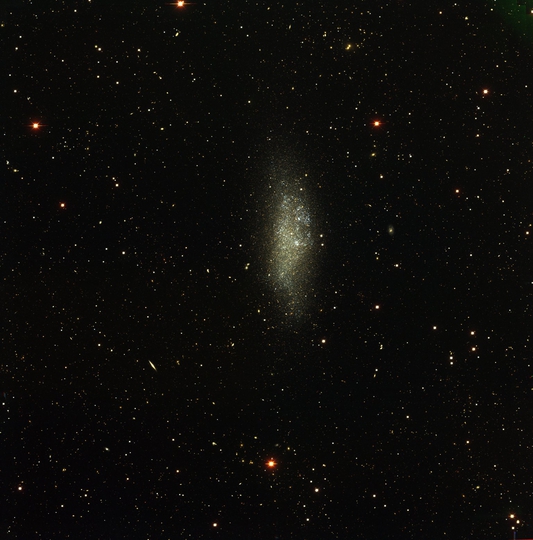
Image Courtesy of Philip Massey & Survey Team Lowell Observatory. Click on image for a larger version. For the original image click here - Warning this is a 14MB file!
With the coming of Autumn the Milky Way and its attendant nebulae and star clusters start to depart from our skies and we start seeing back into deep space and the realm of the galaxies and is the best time to try for some of the more southerly objects.
This month’s challenge, Wolf-Lundmark-Melotte (WLM) is a lot more difficult to see than some of the previous galaxy of the month objects and will need dark transparent southern skies to find. It has been seen with telescopes as small as 33cm but I suspect will need a larger one from your average UK skies.
WLM is an irregular galaxy, although it has also been classified as a dwarf E5 elliptical, which is on the fringes of the local group. First discovered by Max Wolf in 1909 photographically and it was discovered to be a galaxy by Lundmark and Melotte in 1926.
The distance to WLM has been controversial but the latest results place it at about 2.9 million light years. WLM is one of the most isolated members of the local group, its nearest neighbour is IC1613 which is almost 1 million light years away.
WLM has a halo of very old stars that date back to the earliest formation of our local group and these stars are substantially older than the stars in the core of the galaxy. The fact that the galaxy is so isolated and so small (it has a major axis of around 8000 light years but it is very elongated) suggests that the halo probably has not come from cannibalization of another small galaxy but formed with it and has remained undisturbed since that time.
As WLM is located in the southern reaches of the constellation of Cetus along with its large size (11.5 x 4.2 arc minutes) it is going to be a challenge to find from northern latitudes. The other challenge is finding it with popular star charting software as it has the designation UGCA 444 (after an extension to the UGC catalogue) but perhaps will be easiest find by either its MCG designation -03-01-015 or its PGC designation 143. It does also carry the designation DDO 221 from the David Dunlap Observatory catalogue of dwarf galaxies.
It appears that WLM has only one known globular star cluster which is slightly unusual even for galaxies this small.
My only observations of this galaxy are with a 24" from Tenerife and even then it was quite faint.
UGCA 444 RA: 00h 01.948m Dec: -15° 27.02' Mag: 11.0 (B) Size: 11.6'x4.0'
Owen Brazell - Galaxy Section Director
-
September 2011 - Galaxy of the Month
NGC7479 - A Barred Spiral Galaxy in Pegasus
Image Courtesy of Adam Block, Mount Lemmon SkyCenter, University of Arizona. Click on image for a larger version. For more astrophotography images from Adam please visit his Caelum Observatory website.
First discovered by William Herschel in 1784 NGC 7479 is a classical barred spiral galaxy. The orientation of the galaxy is almost face on making it one of the best barred spirals to observe from the northern hemisphere. Sometimes known as the Propeller galaxy it does however have some rather unusual features in that one of the spiral arms is much more prominent than the other. The spiral structure is also unusual in that the arms when observed in the radio spectrum appear to rotate in the opposite direction to those in the visible and near IR. This may have been the result of a merger with a smaller companion about 300 million years ago. The bar is also unusually long.
The galaxy also appears to be a Seyfert with star formation going on in the nuclear regions as well is in the spiral arms. It is this active star formation that has given rise to a couple of supernovae in the galaxy 1990 and 2009. It is obviously one worth watching for further possible supernovae. Observations taken with the GALEX satellite in the Ultraviolet also show numerous HII regions and areas of active star formation.
NGC 7479 is also unusual in that it is extremely isolated. Often starburst galaxies occur because the galaxies have been stirred up by close encounters with other galaxies but that appears not to be the case here. NGC 7479 appears to be at a distance of perhaps 105 million light years and may be associated with the Pegasus galaxy cloud. It is also thought to be about 150 thousand light years across.
Visually the galaxy has been picked up as a faint smudge in telescopes as small as 4" but it will take much a much larger telescope to show the spiral structure. The bar is relatively easy to see as in one of the spiral arms. The other is much more difficult. I find that the visibility of the arms depends very much on the transparency as well as the size of telescope. For those interested in doing the Herschel 400 project NGC 7479 is part of this list. More information on the Herschel 400 project and other Astronomical League observing programs can be found on their website. NGC 7479 was also well observed in the Webb Society Observer's handbook Volume 4 which contains descriptions from a wide range of telescopes.
Owen Brazell - Galaxy Section Director
-
August 2011 - Galaxy of the Month
IC10 - Irregular Galaxy in Cassiopeia
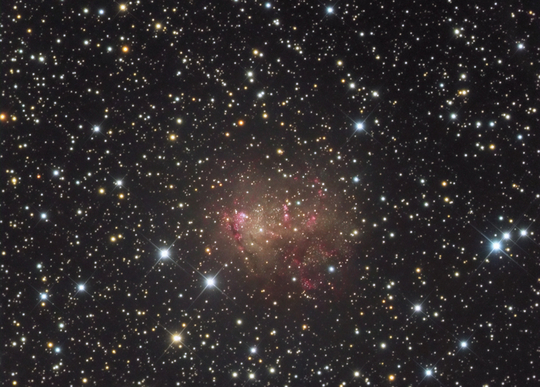
Image Courtesy of Mike Siniscalchi - Long Island, New York. Click on image for a larger version. For more astrophotography images from Mike please visit his website Reflections from Heaven
Although August is perhaps not the best month to study the dwarf irregular galaxy IC 10 it does start to rise high enough to be seen reasonably by the month end.
IC 10 was first discovered by Lewis Swift in 1885 using the 16" refractor at the Warner observatory. Swift described it as
a faint star involved in a very large, extremely faint nebulosity, extremely diffuse
. Hubble suggested that it might be a member of the Local group of galaxies in 1935 but it wasn’t until the 1960’s that its status as a member of the local group was confirmed when its radial velocity suggested it was approaching the Milky Way at around 350 km’s. Measurements in the 1990’s using Cepheid variables confirmed its membership.IC 10 appears to be part of the Andromeda subgroup along with M33 and is also unusual in that it is the only starburst galaxy in the Local Group. It has a much higher density of Wolf-Rayet (WR) stars than the LMC which suggests that there was relatively brief period of time when all these stars formed, perhaps only 10 million years ago. The current star formation rate suggests that all the mass available to form stars will be used up in a few billion years.
Recent observations have led to the discovery of 27 planetary nebulae in IC10, although these are all far beyond visual reach. The spatial distribution of these planetary nebulae may indicate that the galaxy is larger than thought. Infrared observations suggest that IC 10 is depleted in small dust grains and they have been blown out of the galaxy by strong winds associated with the WR stars. IC 10 also has a very large hydrogen envelope surrounding it which appears to rotate in the opposite direction to the main visual part of the galaxy. IC 10 also appears to contain one of the largest known stellar mass black holes.
IC 10’s location within the Milky Way in Cas means that it is a relatively difficult object to observe, see the finder chart. Its size also means that you need to use a medium power eyepiece to fit it all in. There are many HII regions in the galaxy and these might respond to a nebula filter. It would be interesting to hear if these are within range of large sized amateur instruments. Because of the structure of its HII regions it does provide a good target for imagers.
Owen Brazell - Galaxy Section Director
-
July 2011 - Galaxy of the Month
NGC 5907
Image copyright ©2006-2008 R Jay GaBany. Click on image for a larger version. For more images from R. Jay GaBany please take a look at his website.
Summer skies preclude observing faint objects from mid northern latitudes so our galaxy this month is the bright edge on spiral in Draco NGC 5907.
NGC 5907 was first discovered by William Herschel in 1788 with his 20ft (18.7" mirror) from Slough. It is also known as the Splinter galaxy and is one of the best and brightest of the edge on galaxies, and appears to be a standard SA(s)c.
It is believed to be part of the galaxy group that includes NGC 5866 (M102). This is a very exclusive group consisting of just the three galaxies NGC 5866, NGC 5907 and NGC 5879. They form an equilateral triangle about a degree on a side. A wide field view showing all three galaxies can be found on the Starry Vistas website.
NGC 5906 and NGC 5907 are sometimes confused. It appears that NGC 5906 is actually a knot in NGC 5907, although occasionally the galaxy also goes under the same number. This confusion appears to have come from observations made at Birr with the 72".
NGC 5907 is an interesting galaxy in many ways as it seems to consist of mainly dwarf stars of low metallicity. Very few giant stars have been found in it. The galaxy appears to be about 50 million light years away.
It became famous in 2008 when an image taken by R Jay GaBany showed tidal streams wrapped around it which may represent the dying orbits of a dwarf galaxy that then became absorbed into the main galaxy maybe 4 billion years ago. These stars streams may orbit as much as 150 thousand pc from the galaxy. This may also be the way that polar ring galaxies form. Our own Milky Way galaxy contains similar star streams that are thought to be the remnants of recently ingested dwarf galaxies showing galactic cannibalism is still alive and well. What makes this image more remarkable is that it was taken by an amateur.
Recent interactions also seem to have caused NGC 5907 to have a warped disk. The warping galaxy is thought to be the small dwarf galaxy KUG 1513+566. As NGC 5907 is so bright it should be visible in binoculars and small telescopes. Owners of large telescopes might like to look for the 15th magnitude galaxy CGCG 297-11 about 7 arc minutes preceding.
NGC 5907 has also been home to one supernova in the last 100 years (in 1940).
Owen Brazell - Galaxy Section Director
-
June 2011 - Galaxy of the Month
NGC 6946
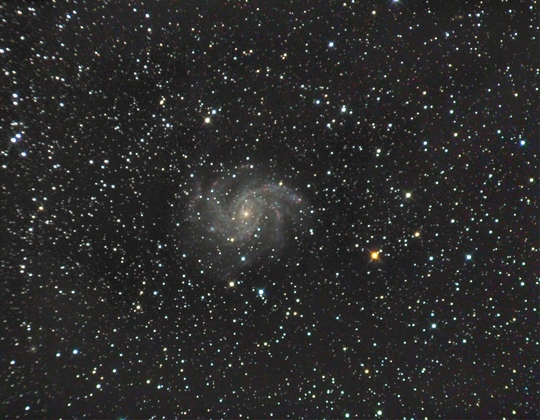
Image Courtesy of Dietmar Hager - Linz, Austria. Click on image for a larger version. For more images from Dietmar please visit his website.
The summer is perhaps not the best known season for galaxies but even in constellations better known for nebulae and clusters there are still some bright examples. NGC 6946 on the Cygnus /Cepheus border, better known as the Firecracker galaxy from the number of supernovae that have appeared in it, is one of these.
First discovered by William Herschel in 1798, NGC 6946 is a face on spiral, not dissimilar to M101, which I think would be better known if it was not suffering 1.6 magnitudes of extinction from within our own galaxy. Once believed to be a member of our local group NGC 6946 is now thought to be at a distance of 6.5 Mpc (20 million light years) and as such outside the gravitational radius of the local group. There does appear however to be quite a spread in the distance measurements with a number of sources suggesting it may be as close as 10 million light years (3 Mpc).
NGC 6946 appears to be undergoing a burst of star formation which is unusual in isolated galaxies because these are often triggered by interactions with other galaxies. As far as we can tell NGC 6946 does not appear to be associated with any other galaxy groups. This burst of star formation is probably also the reason that 6 supernovae have been seen in NGC 6946 over the last 100 years or so. NGC 6543 also contains a nuclear star burst which recent observations suggest may well be associated with the formation of a bar in the core of the galaxy.
The morphological classification of NGC 6946 is SAB (rs)cd, relating to its barred spiral nature The magnitude of the galaxy varies with waveband and a blue magnitude of 9.6 is listed in NED. Various sources however give NGC 6946 a visual magnitude of around 8.9. Despite this bright integrated magnitude NGC 6946 has a very low surface brightness due to its size (11.6’ x 9.8’) and it will be likely that a 22cm scope will be required to show any details of the spiral arms at all. Smaller aperture telescopes will show a faint haze and the core. Indeed it does look like a faint globular cluster. Larger instruments should be able to pick out the spiral arms and some of the HII regions that line them. The included finder chart shows some of these regions. A low power field may also show the cluster NGC 6939 to the North west and observers with large telescopes may be able to pick out the edge on galaxy UGC 11583 nearby as well.
Owen Brazell - Galaxy Section Director
-
May 2011 - Galaxy of the Month
Abell 2151 - Hercules Cluster
Image Courtesy of Russell Croman, click on image for a larger version. A detailed finder chart for the cluster is available along with a table of the galaxies.
The constellation of Hercules is perhaps more associated with globular clusters than galaxies but it does contain the spectacular cluster Abell 2151.
Unlike other galaxy clusters such as Coma (AGC 1656), the Hercules cluster is dominated by spiral galaxies. Many of the galaxies appear to be interacting as well and in many ways Abell 2151 represents what we think galaxy clusters may have looked like in the early universe.
Abell 2151 is however relatively close with a distance index of 1 and a distance of perhaps 500 million light years. It spans a fairly large area on the sky covering perhaps a degree with maybe a 100 galaxies in that area, the brightest of which are around 13.5 magnitude.
As such this is going to be a target for larger telescopes, probably in the 16-20" range but some of the brighter ones may be seen with smaller apertures.
The brighter NGC galaxies in the cluster appear to have had a variety of discoverers from William Herschel through Stephan and Swift, although there are also a collection of IC objects there, the majority discovered by Swift.
Steve Gottlieb’s observing notes on the cluster can be found on his website. Note however these were made by one of the worlds best visual observers with a large telescope form a very dark site. Visual observations of the clusters are also covered in the NSOG Volume 2.
Abell 2151 does seem to be a relatively popular target for imagers from the number of images available on the web, as always Google is your friend for finding these although the ones from Tony Hallas and Jim Misti along with Russell’s appear to be some of the best.
If you find Abell 2151 too easy then the other bright(ish) galaxy cluster in Hercules is Abell 2199 although this is a much more difficult challenge. As always if you observe this cluster then notes on the society newsgroup or to me would be appreciated. If you make this a project then the editor of DSO would love an article as well.
Owen Brazell - Galaxy Section Director
-
April 2011 - Galaxy of the Month
NGC 3718
Click on image for a larger version and for more images from Philip Perkins please visit his website
Our galaxy of the month this month is the distorted spiral galaxy NGC 3718. Also known as Arp 214 the galaxy is distinguished by distorted spiral arms and a dust lane wrapped across its centre. NGC 3718 is also a Type 2 Seyfert AGN.
First discovered by William Herschel in 1789 both NGC 3718 and the probable cause of its distortion NGC 3729 make a nice galaxy pair for northern observers . NGC 3729 also appears distorted but not as much as 3718 It appears that NGC 3718 could be evolving into a polar ring galaxy. The nucleus of NGC 3718 is not circular but definitely box shaped. Both 3718 and 3729 are classified as SB (barred spirals) but obviously they are both distorted from this basic designation.
The Webb DSOH Volume 4 suggests that it is faint but visible in a 6" whilst more modern observations from the NSOG suggest that a 30cm scope is need to see pair well.
In the same field is the small group Hickson 56. Comprised of 5 galaxies this will be a challenge for larger scopes. Three of the group appear to be interacting. I was quite surprised however when observing NGC 3718 with my 20" last spring at the Kelling Heath star party to see that the group appeared quite obvious. With one of the modern superwide field eyepieces both NGC 3718 and NGC 3729 will appear in the same field along with Hickson 56. Interestingly when the astronomers using the 72" telescope at Birr observed NGC 3718 they missed this small group of galaxies nearby. Must have been a murky night with a tarnished mirror. You may need a power of around 250x to split the group.
NGC 3718 and 3729 are about 40 million light years away compared to the 400 million light years for Hickson 56. This grouping seems popular with imagers, witness the fine image from Philip Perkins, but I have not seen too many visual observations of it.
Associated with this the BAA Deep Sky Section and the Webb Galaxy Section are looking at doing a joint project on observing the Hickson galaxy groups and we are putting together the plans for this project shortly.
Owen Brazell - Galaxy Section Director
-
March 2011 - Galaxy of the Month
NGC4216 in Virgo
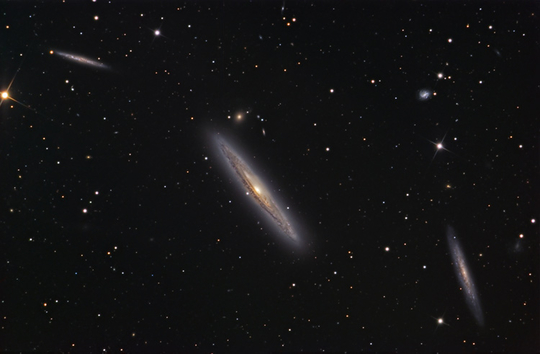
This image is courtesy of Johannes Schedler, Panther Observatory in Austria. Click on image for a larger version. We also provide a high resolution finder chart.
In order to try and revitalize interest in the Galaxy Section I have decided to try and post a Galaxy of the Month target. Observations both electronic and visual are encouraged of the object to be submitted either to the Galaxy Section Director, the Editor of DSO or on the Yahoo group. The challenges will vary between those visible for both new observers and those with larger instruments. Given that we are starting in February/March I thought I would start with an object from the Virgo cluster of galaxies and to go for a 3 in one challenge.
NGC 4216 is a bright (10.1 mag) edge on spiral galaxy classified as SBb which appears to be part of a small group of galaxies involved in the main Virgo cluster.
Through small telescopes you can see the core of the galaxy but as you move up in aperture not only does more detail appear in the galaxy itself, including the dust lane cutting across but also the neighbouring edge on spiral galaxies NGC 4206 and NGC 4222.
I remember coming across this group by accident when observing with Stewart Moore and a 24" in Tenerife and failing to identify it. We had got lost in Virgo by that time!!. For observers with very large telescopes there is also the small galaxy CGCG 69-113 in the same field.
There is a fine deep image of this galaxy showing the star streams from its merger with several smaller galaxies on the NASA APOD site and also a very nice image at Johannes Schedler's Panther Observatory website.
NGC 4216 is of interest as it appears to be blue shifted because due to its internal motion within the Virgo cluster. The galaxy itself is about 40 million light years away and is suspected to be a barred spiral galaxy but these classifications are always difficult when the galaxy is so edge on. NGC 4216 was discovered by William Herschel in 1784 and assigned by him to his class 1 objects.
Owen Brazell - Galaxy Section Director
